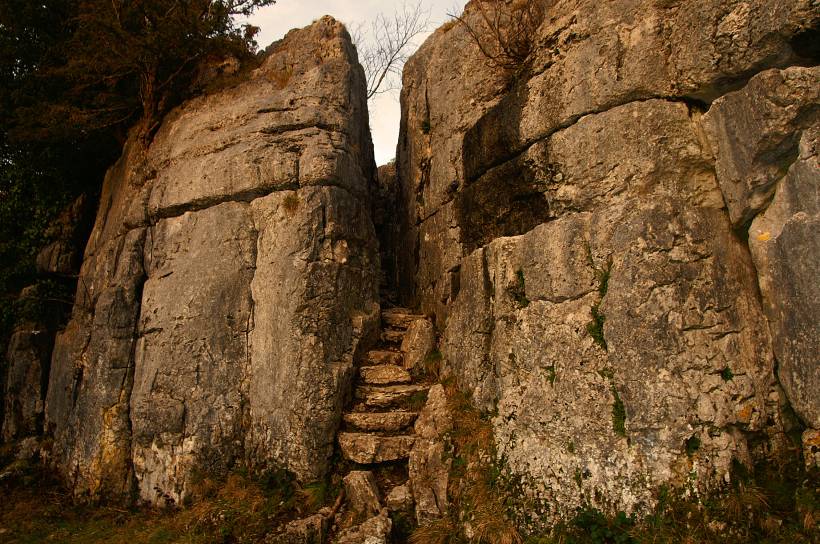
Join us on
Please visit the Sitemap to see the full range of information on this site
MountainWalk.co.uk is produced by Trish Haill Associates Copyright
Have you climbed Ben Nevis, Snowdon or Scafell Pike? Or taken part in the Three Peaks Challenge? Or have a special walk you'd like to share? We'd love to here from you! Join us on Facebook or Send us an email.
Ulverston and South West Cumbria
Although lying just outside the Lake District National Park Ulverston and the south western corner of Cumbria is close to the lakes and has a charm all of its own.
.
Ulverston
.
Ulverston is a lively and vibrant historic market town with festivals and events taking place throughout the year. With old buildings and cobbled streets it makes an attractive tourist base. To the north of Ulverston are the hills and fells of the Lake District, to the south the land is relatively flat lying.
Being the birthplace of Stan Laurel it is home to the Laurel and Hardy Museum and houses a large collection of photographs and memerobilia
Being the birthplace of Stan Laurel it is home to the Laurel and Hardy Museum and houses a large collection of photographs and memerobilia
To get panoramic views of the surrounding area extending to Morecambe Bay and the Lake District you can climb to the top of the 100 foot high Hoard Monument, built in 1850 to commemorate the statesman Sir John Barrow.
The Lakes Glass Centre can be found in Ulverston and nearby is Conishead Priory and Gardens. Founded originally as a hospital for the poor in 1160 the current building is a prime example of Gothic architecture. There are tours of the house at the weekend although it's current use is as an international Buddhist College.
Ulverston is the starting point for the 70 mile Cumbrian Way. The majority of the walk is within the lake District National Park, and passes through Coniston and Keswick, and ending at Carlisle.
The Stagecoach bus from Ulverston will take you to the Lakeland Motor Museum which is near the southern end of Windermere. It has a unique collection of 30,000 exhibits which have been brought together over nearly 50 years. A great all weather venue with plenty to do and see. And it is home to the Campbell Bluebird Museum.
Broughton-in-Furness
Broughton-in-Furness is another pretty market town dating back to the 11th century and evidence of its past can be seen in the market square where the old stocks still stand together with slate slabs from which fish used to be sold. It is situated on the Duddon Estuary where the restored remains of Duddon Ironworks can be visited. Duddon Ironworks is a blast furnace built in the 1700s which needed charcoal and water power to work. It was therefore built close to the River Duddon and near to woods. The water from the river turned a huge wheel which drove bellows to pump air into the furnace. These ironworks were in use from 1736 to 1866 and are one of the best examples in Britain.
Broughton-in-Furness is another pretty market town dating back to the 11th century and evidence of its past can be seen in the market square where the old stocks still stand together with slate slabs from which fish used to be sold. It is situated on the Duddon Estuary where the restored remains of Duddon Ironworks can be visited. Duddon Ironworks is a blast furnace built in the 1700s which needed charcoal and water power to work. It was therefore built close to the River Duddon and near to woods. The water from the river turned a huge wheel which drove bellows to pump air into the furnace. These ironworks were in use from 1736 to 1866 and are one of the best examples in Britain.
Barrow-in-Furness
Barrow-in-Furness is a larger Victorian town with an industrial and maritime heritage. It is well placed; surrounded by beautiful beaches and scenery, and with easy access to the Lake District. It is often viewed as a wet weather day trip location, although worth considering as a base for a longer stay. The Dock Museum (free entrance) tracks the social and industrial history of the town - in the 19th century it became the biggest iron and steel centre in the world, and a major shipbuilding port. Close by at Dalton-on-Furness is the South Lakes Wild Animal Park which houses some of the world's rarest species including Sumatran and Siberian tigers, and African lions. Also worth a visit is Dalton Castle which was bhuilt in the 14th century for the Abbot of Furness Abbey.
Furness Abbey itself is managed by English Heritage consists of impressive remains of an Abbey built by Stephen before he became King of England. Preservation work in 2012 unearthed a hoard of medieval treasure discovered in a grave consisting of a crozier and jewelled ring. The finds are now on display in the abbey. It is assumed the bones in the grave are those of an abbot, and dates prior to the dissolution of the monatries in 1537.
Morecambe Bay
With its bay lying across the counties of Lancashire and Cumbria Morecambe is a classic example of a typical English seaside town like a mini Blackpool, but with the advantage of the backdrop of the Lakeland mountains. When the tide goes out it reveals over 120 square miles of sand in the bay. Possibly most famous for the Morecambe Bay Potted Shrimps, and infamous for the treacherous nature of the sands.
Up to 1857 travellers used to take a service crossing the sands by horse drawn coaches in preference to the long detour via Levens Bridge, but the service closed in 1857 due to the sinking and overturning of the coaches. Crossing is only possible at low tides, and even now only with a professional guide. Guides have been employed here since 1536. As well as the ever shifting channels there is the extreme danger of quick sands. The guides test the routes they use daily. Constant changes in the sands mean the starting point of the walk across can change. Crossing the sands can be fun, but never be attempted to cross without an experienced guide.
Grange-over-Sands is a quiet seaside retreat on the shores of Morecambe bay. In 1887 the Furness Railway came to the town changing it from the small hamlet that it once was. It is just 7 miles from Windermere and its quaint charm can make it a good place to stay, combining both a seaside holiday with your chance to explore the lakes.
Near Grange-over-Sands is Holker Hall, the family home of Lord and Lady Cavendish which has remained in the ownership of the same family for more than 400 years. The house suffered a major fire in 1871 and was restored in the Victorian style. There are tours of the house which is a magnificent stately home, and the gardens are spectacular with a number of suggested walks can be taken varying from 30 minutes to an hour to complete. Some are suitable for wheelchair/pushchair users. With an adventure playground and picnic area as well as a labyrinth children will be kept amused.
On the border of Cumbria and Lancashire is the small village of Beetham, situated in an area of outstanding natural beauty. The Heron Corn Mill is one of the few working mills in the area and has been working for over 900 years. The mill itself is a Grade II listed building and the operational 18th corn mills uses the water mill in traditional ways. Unfortunately the mill will not be open to visitors until September 2013 due to improvements to the site.
Children in particular will enjoy climbing the Fairy Steps outside of Beetham - limestone steps form a narrow stairway up a limestone fissure which legend has it were used by fairies. If you manage to climb the steps without touching the sides, the fairies will grant you a wish. However, you have to be extremely thin to manage this feat! An iron ring is set at the top to the north of the Fairy Steps which is said to have been used to pull coffins up the rockface being part of the Coffin Trail - or it might have simply been used to haul up sacks of grain and flour purchased at the shop in Beetham.

The Fairy Steps
Grizdale Forest
Grisdale Forest is situated between the lakes of Coniston and Windermere. With challenging mountain bike trails (or easier if you wish), trails for walking and horseriding it can make for a great day out. The forest is famous for its 60 sculptures dotted across the forest. They can be found alongside the different trails. For active children there is a Go Ape centre here which provides 2 to 3 hours of tree top adventure on zip wires and tarzen swings.
See the other Lake District Guides
The Wainwrights
Outdoor Activities in the Lake District
Windermere and the Southern Lakes
Kendal and District
Keswick and the North Lakes
Coast and Western Lakes
Penrith and the Eastern Lakes
The Wainwrights
Outdoor Activities in the Lake District
Windermere and the Southern Lakes
Kendal and District
Keswick and the North Lakes
Coast and Western Lakes
Penrith and the Eastern Lakes
